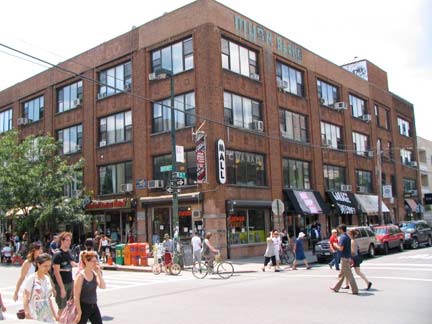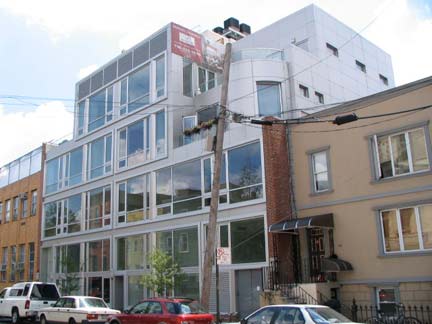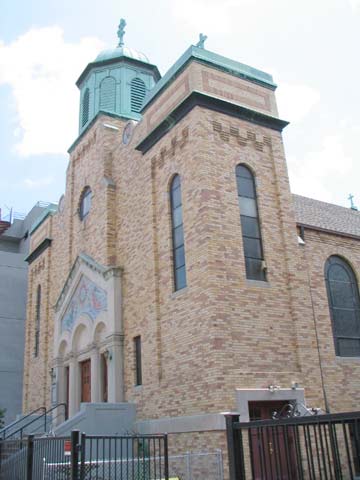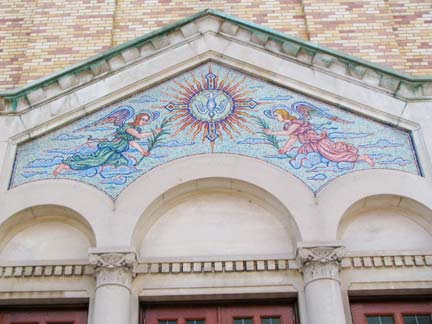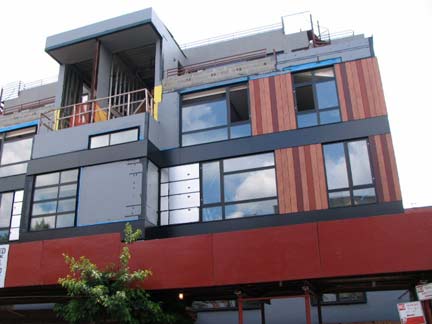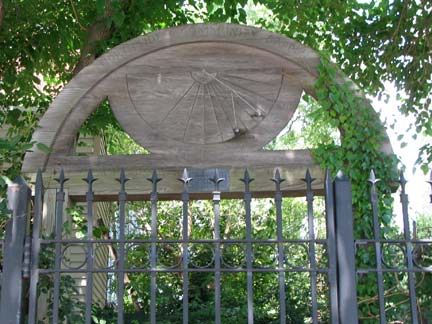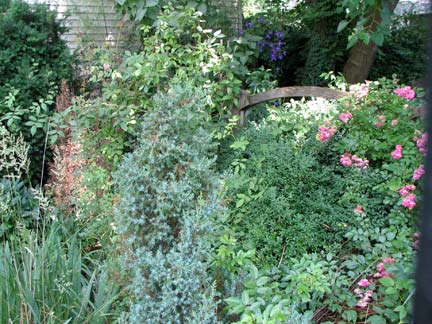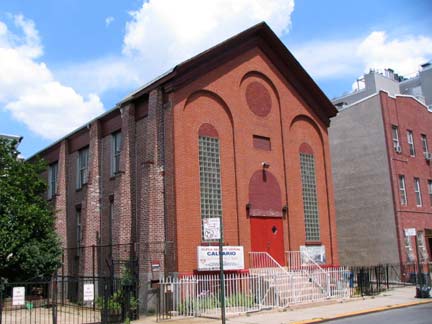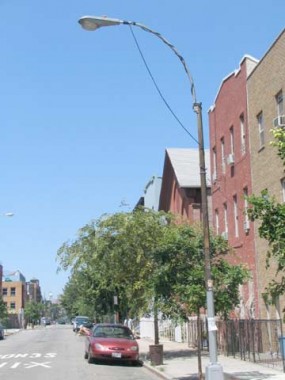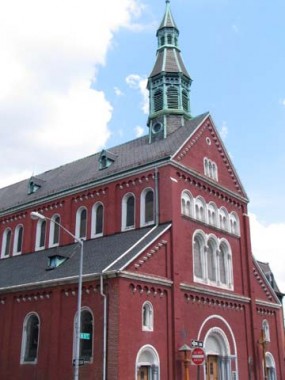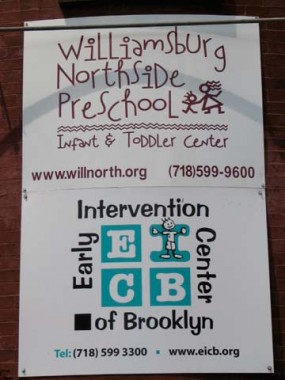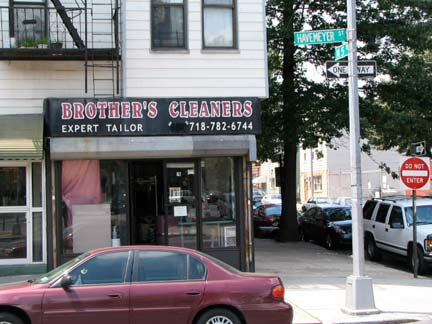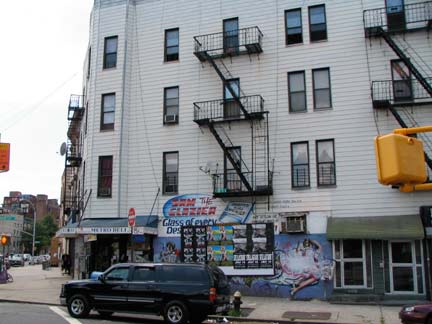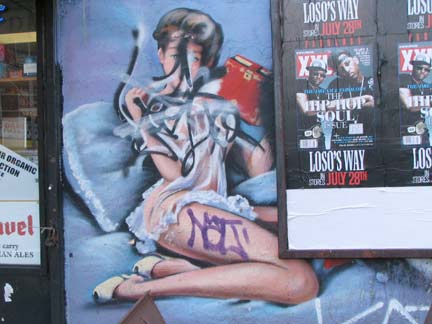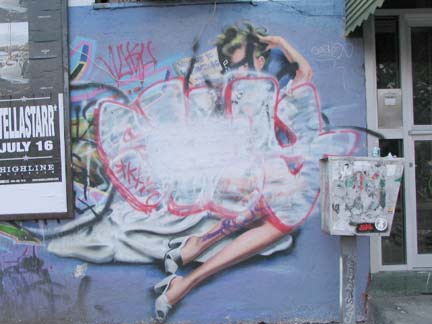Fresh from staggering up and down North 4th in Williamsburg, I next turned my attention a block away on North 5th, where I found some fare that presented a more varied appearance, with new million-dollar condos sharing space with aluminum-sided houses that have not changed appearance since the Truman Administration, and brick churches that haven’t been significantly altered since the Rutherford B. Hayes administration. Taken as a whole the new money pouring into the area has shoehorned a lot of intimidating-looking glass-fronted architecture into an area that still proudly waves the flags of its former lunch-pail past.
The Real Form Girdle Company, Bedford and North 5th, was re-fitted as a mall relatively early on in Willieburg’s renaissance; the metal awning says “Girdle Building” and you can still make out the faint lettering notating the building’s old use at the roof line. There’s a furniture store, markets, exercise studios and Earwax, a popular record store. Given rapidly-changing women’s fashion, if girdles make a comeback they will probably have them there.
I was unaware that they were still calling buildings “The Rialto,” but I don’t believe it’s an ironic usage by the developers of 150 North 5th — they actually are that pretentious. On the building’s website it states this is a conversion from a carriage house, but Brooklyn 11211 differs:
The “carriage house” part probably refers to stables that were once located on this site (at least as far back as 1898). The buildings (there were four of them) look to have been completely redone circa 1932 – 1934 at which time they housed a “wet wash” laundry. In the 1960s, a cardboard box manufacturer was located there.
So yes, there were once horses and maybe even carriages here, but lets be honest and call a stable a stable. Sure, the project “combines the flavor of old construction methods and prewar elegance [of a stable?] with sleek and modern finishes”, but if you can find the carriage house in this mess in this mess of sleek modern finishes, they should give you a free vacation.
Williamsburg’s remaining Eastern Europeanflavor is reflected here at the Holy Ghost Ukrainian Catholic Church at 161 N. 5th; the church is part of the Ukrainian Catholic Eparchy of Stamford, CT.
Another luxury building, with the large windows popular in the early 21st Century, is going up on Holy Ghost’s eastern flank.
A sliver of territory on the SE corner of Driggs Avenue and North 5th provides some much needed green in Williamsburg as the Nicholas Polonski Northside Community Garden. It predates Williamsburg’s redevelopment by almost two decades, having originated in 1980. Here’s a list of all of Brooklyn’s community gardens.
Originally St. Matthew’s First Evangelical Lutheran Church, the Iglesia Bautista Hispania Calvaro was originally constructed in 1864, during the Civil War. Original buttresses survive on the sides of the church.
In April 2008 I grabbed these shots of a now-rare in the 5 boroughs Westinghouse Silverliner luminaire in front of yet another new glass condo. In 2009 it had been replaced by a modern Thomas Betts lume.
At the conjunction of N. 5th, Havemeyer and Metropolitan (quite a mouthful) stands the 1870 Roman Catholic Church of the Annunciation (A.J. Berlenbach, Jr., architect). AIA Guide: “A crisply detailed and lovingly maintained Lombardian Romanesque basilica.”
If anything, I liked the Gothic school associated with the church across Havemeyer even better — look at the beautifully rendered lettering in Latin on the corner. Compare school signage in 1870 and 2009. “Annunciation” refers to the New Testament story of an angel, Gabriel, appearing to Mary informing her that she would be the mother of Jesus.
Brother’s Cleaners, Havemeyer and N. 5th, and signage for Sam the Glazier, Havemeyer and Metropolitan. Let’s zoom in on that old Sam’s sign, shall we?
OK, graffitists, I’ve had it. Why oh why would you tag over pulchritude like this?
Photographed June 27, 2009; page completed June 30


